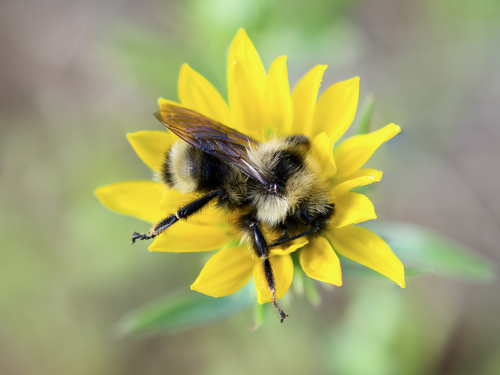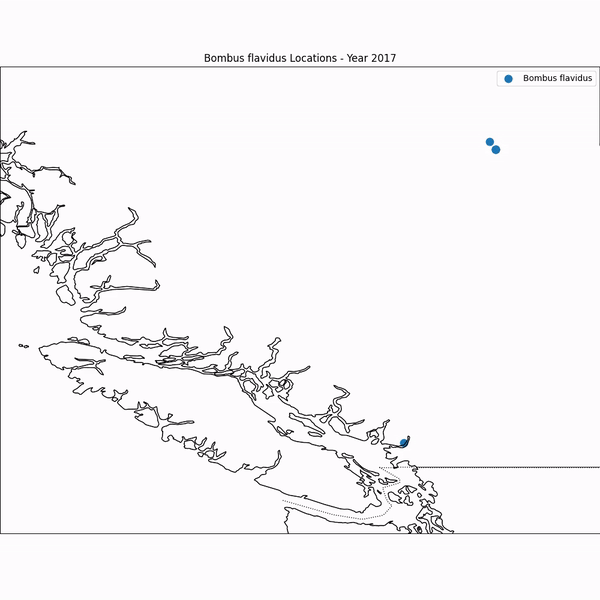Feature Bee - Bombus flavidus
Reading time: 4 minutes
Bombus flavidus - after a long absence the yellowish cuckoo bumblebee is back on Galiano!

Background
B. flavidus (also known as B. fernaldae) the yellowish cuckoo bumblebee is the world’s most widespread bumblebee (1). Cuckoo bumblebees are social parasites; bees that have lost the ability to collect pollen and raise their young. Instead, they invade the nests of other bumblebee species, take over the colony by killing or subduing the queen, and make the worker bees raise their offspring for them. This species is thought to takeover nests of a wide range of bumblebees, including those in the subgenus Pyrobombus – the fiery tailed bees. Galiano’s six bumblebee species are all Pyrobombus: B. flavifrons (yellow-fronted bumblebee); B. melanopygus (black-tailed bumblebee); B. mixtus (fuzzy-horned bumblebee); B. sitkensis (Sitka bumblebee); B. vancouverensis (Vancouver bumblebee); and B. vosnesenskii (yellow-faced bumblebee).
B. flavidus in the Pacific Maritime
If we take a look at the historical record, we find B. flavidus was first reported in the Pacific Maritime region in 1934, with specimens collected in Agassiz, Hope, and Mt Cheam in the Fraser Valley (2). The next documentation was in the 1950s, by which time, in addition to the previous specimens found in the Lower Mainland, B. flavidus was also found in Manning Park, the Greater Vancouver area, and on Vancouver Island (3). In 2005, specimens were again collected on Vancouver Island and subsequently, in 2013, in Abbotsford and Tsawassen (4).
Beginning in 2017, iNaturalist (5) observations have significantly added to the knowledge base giving insight into more recent B. flavidus distribution in this region. As of September, 2024, a total of 286 research grade observations have been submitted to iNat, beginning with a singleton in 2013 followed by multiple sightings from 2017 onward. These observations are consistent with B. flavidus being wide ranging throughout BC (6).

Since the first iNat observation in 2017, B. flavidus has been repeatedly spotted on the North Shore and up the Sunshine Coast, among other places. It made its iNat debut on Vancouver Island in 2023, with subsequent sightings in Victoria, Nanaimo and the Gulf Islands in 2024. The figures below show annual trends in B. flavidus observations from 2017 to2024.


Plant associations
Being a cuckoo bee, B. flavidus chooses flowers for their nectar not their pollen. To better understand cuckoo bees habits, we looked in our BC BeePlant Database (generated from iNat observations and Plantnet ID to Nov, 2023) to check out which flowering plants B. flavidus has been photographed on most frequently. We have 51 observations for B. flavidus that include 25 genera of plants (Table). B. flavidus was most commonly seen on goldenrod, pearly everlasting, yarrow, fleabane, sow thistles, and American asters. Checking the recent Galiano observations, we saw the plant hosts were goldenrod, topped lavendar, oxeye daisy, and gumplants. Although it looks like B. flavidus may prefer nectaring on some flowers over others, it is clearly a generalist when it comes to snacking.

So what do we know about B. flavidus on Galiano?
Andrew Simon has reported in depth on the historical changes in Galiano’s bumblebee community (7). The Biodiversity Galiano Lifelist includes 11 species that have at some point in time been found on Galiano. Of these, six are currently present (listed above), three are likely extirpated; i.e., locally extinct – B. insularis, B. occidentalis, and B. suckleyi – and two others B. fervidus and B. flavidus have only ever turned up once in the historical record (7).
That is until now!!
As reported in iNat, B. flavidus was spotted mid-Island in late May of this year, and then several more times at the South end of Galiano in early June.
Happily, these little cuckoo bumblebees are back, and if they successfully stole bumblebee homes on Galiano this year, we may see even more of them next year. And, who knows, as Galiano’s iNat enthusiasts continue to upload new observations, perhaps in future we’ll see other “lost” bumblebee species reappearing, and new ones arriving to make Galiano their home.
References
(1) Melissa Mayer. Cuckoo Combo: Re-Classification Makes Bombus flavidus World’s Most Widespread Bumble Bee.
(2) Brown, W.J. 1934. The Entomological Record 1931, 1932, 1933. Report of the Quebec Society for the Protection of Plants 1932-1934. 25-26: 140-162.
(3) Buckell, E.R. 1951. Records of Bees from British Columbia: Bombidae. Proceedings of the Entomological Society of British Columbia. 47: 7-24.
(4) Guzman LM, Kelly T, Elle E. A data set for pollinator diversity and their interactions with plants in the Pacific Northwest. Ecology. 2023 Feb;104(2):e3927.
(5) iNaturalist.ca, Accessed Sept, 2024.
(6) NatureServe. Accessed Sept, 2024.
(7) Simon AD, Best LR, Starzomski BM. Evidence of Bumble Bee Extirpation and Colonization, Galiano Island, British Columbia, Canada. Northwest Science. 2023 Dec;96(3-4):206-19.